Hugo Gernsback
Hugo Gernsback (/ˈɡɜːrnzˌbæk/; born Hugo Gernsbacher, August 16, 1884 – August 19, 1967) was a Luxembourgish-American inventor, writer, editor, and magazine publisher, best known for publications including the first science fiction magazine. His contributions to the genre as publisher—although not as a writer—were so significant that, along with the novelists H. G. Wells and Jules Verne, he is sometimes called "The Father of Science Fiction".[1] In his honour, annual awards presented at the World Science Fiction Convention are named the "Hugos".[2]
Hugo Gernsback | |
|---|---|
 Gernsback portrait by Fabian, date unknown | |
| Born | Hugo Gernsbacher 16 August 1884 Luxembourg City, Luxembourg |
| Died | August 19, 1967 (aged 83) Manhattan, New York, US |
| Pen name | Beno Ruckshagg, Erno Shuckbagg, Grace G. Hucksnob, Grego Banshuck, Greno Gashbuck, Gus N. Habergock, Kars Gugenchob |
| Occupation | Inventor, magazine publisher, editor, writer |
| Nationality | Luxembourgish, American |
| Period | 1911–1967 (science fiction) |
| Genre | Science fiction |
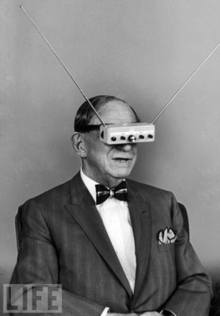
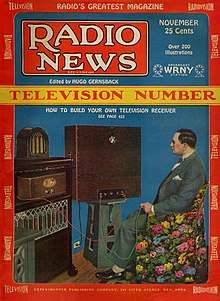
Personal life
Gernsback was born in 1884 in Luxembourg City, to Berta (Dürlacher), a housewife, and Moritz Gernsbacher, a winemaker.[3] His family was Jewish.[4] Gernsback emigrated to the United States in 1904 and later became a naturalized citizen.[5] He married three times: to Rose Harvey in 1906, Dorothy Kantrowitz in 1921, and Mary Hancher in 1951. In 1925, he founded radio station WRNY, which was broadcast from the 18th floor of the Roosevelt Hotel in New York City. In 1928, WRNY aired some of the first television broadcasts. During the show, audio stopped and each artist waved or bowed onscreen. When audio resumed, they performed. Gernsback is also considered a pioneer in amateur radio.
Before helping to create science fiction, Gernsback was an entrepreneur in the electronics industry, importing radio parts from Europe to the United States and helping to popularize amateur "wireless". In April 1908 he founded Modern Electrics, the world's first magazine about both electronics and radio, called "wireless" at the time. While the cover of the magazine itself states it was a catalog, most historians note that it contained articles, features, and plotlines, qualifying it as a magazine.[6]
Under its auspices, in January 1909, he founded the Wireless Association of America, which had 10,000 members within a year. In 1912, Gernsback said that he estimated 400,000 people in the U.S. were involved in amateur radio. In 1913, he founded a similar magazine, The Electrical Experimenter, which became Science and Invention in 1920. It was in these magazines that he began including scientific fiction stories alongside science journalism—including his novel Ralph 124C 41+ which he ran for 12 months from April 1911 in Modern Electrics.[7]
Hugo Gernsback started the Radio News magazine for amateur radio enthusiasts in 1919.
He died at Roosevelt Hospital (Mount Sinai West as of 2020) in New York City on August 19, 1967.[8]
Science fiction
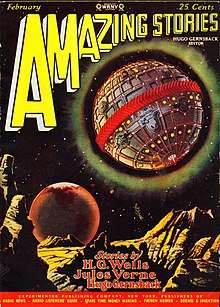

Gernsback provided a forum for the modern genre of science fiction in 1926 by founding the first magazine dedicated to it, Amazing Stories. The inaugural April issue comprised a one-page editorial and reissues of six stories, three less than ten years old and three by Poe, Verne, and Wells.[7][lower-alpha 1] He said he became interested in the concept after reading a translation of the work of Percival Lowell as a child. His idea of a perfect science fiction story was "75 percent literature interwoven with 25 percent science".[9] He also played an important role in starting science fiction fandom, by organizing the Science Fiction League[10] and by publishing the addresses of people who wrote letters to his magazines. Fans began to organize, and became aware of themselves as a movement, a social force; this was probably decisive for the subsequent history of the genre. He also created the term "science fiction", though he preferred the term "scientifiction".[9]
In 1929, he lost ownership of his first magazines after a bankruptcy lawsuit. There is some debate about whether this process was genuine, manipulated by publisher Bernarr Macfadden, or was a Gernsback scheme to begin another company. After losing control of Amazing Stories, Gernsback founded two new science fiction magazines, Science Wonder Stories and Air Wonder Stories. A year later, due to Depression-era financial troubles, the two were merged into Wonder Stories, which Gernsback continued to publish until 1936, when it was sold to Thrilling Publications and renamed Thrilling Wonder Stories. Gernsback returned in 1952–53 with Science-Fiction Plus.
Gernsback was noted for sharp (and sometimes shady[11]) business practices,[12] and for paying his writers extremely low fees[13] or not paying them at all.[14] H. P. Lovecraft and Clark Ashton Smith referred to him as "Hugo the Rat".[15]
As Barry Malzberg has said:
Gernsback's venality and corruption, his sleaziness and his utter disregard for the financial rights of authors, have been well documented and discussed in critical and fan literature. That the founder of genre science fiction who gave his name to the field's most prestigious award and who was the Guest of Honor at the 1952 Worldcon was pretty much a crook (and a contemptuous crook who stiffed his writers but paid himself $100K a year as President of Gernsback Publications) has been clearly established.[16]
Jack Williamson, who had to hire an attorney associated with the American Fiction Guild to force Gernsback to pay him, summed up his importance for the genre:
At any rate, his main influence in the field was simply to start Amazing and Wonder Stories and get SF out to the public newsstands—and to name the genre he had earlier called "scientifiction."[17]
Fiction
Frederik Pohl said in 1965 that Gernsback's Amazing Stories published "the kind of stories Gernsback himself used to write: a sort of animated catalogue of gadgets".[18] Gernsback's fiction includes the novel Ralph 124C 41+; the title is a pun on the phrase "one to foresee for many" ("one plus"). Even though Ralph 124C 41+ has been described as pioneering many ideas and themes found in later SF work,[19] it has often been neglected due to what most critics deem poor artistic quality.[20] Author Brian Aldiss called the story a "tawdry illiterate tale" and a "sorry concoction",[21] while author and editor Lester del Rey called it "simply dreadful."[22] While most other modern critics have little positive to say about the story's writing, Ralph 124C 41+ is considered by science fiction critic Gary Westfahl as "essential text for all studies of science fiction."[23]
Gernsback's second novel, Baron Münchausen's Scientific Adventures, was serialized in Amazing Stories in 1928.
Gernsback's third (and final) novel, Ultimate World, written c. 1958, was not published until 1971. Lester del Rey described it simply as "a bad book", marked more by routine social commentary than by scientific insight or extrapolation.[24] James Blish, in a caustic review, described the novel as "incompetent, pedantic, graceless, incredible, unpopulated and boring" and concluded that its publication "accomplishes nothing but the placing of a blot on the memory of a justly honored man."[25]
Gernsback combined his fiction and science into Everyday Science and Mechanics magazine, serving as the editor in the 1930s.
Legacy
In 1954, Gernsback was created an Officer of Luxembourg's Order of the Oak Crown, an honor equivalent to being knighted.[26]
The Hugo Awards or "Hugos" are the annual achievement awards presented at the World Science Fiction Convention, selected in a process that ends with vote by current Convention members. They originated and acquired the "Hugo" nickname during the 1950s and were formally defined as a convention responsibility under the name "Science Fiction Achievement Awards" early in the 1960s. The nickname soon became almost universal and its use legally protected; "Hugo Award(s)" replaced the longer name in all official uses after the 1991 cycle.[2][27]
In 1960 Gernsback received a special Hugo Award as "The Father of Magazine Science Fiction".[28][29]
The Science Fiction and Fantasy Hall of Fame inducted him in 1996, its inaugural class of two deceased and two living persons.[30]
Science fiction author Brian W. Aldiss held a contrary view about Gernsback's contributions: "It is easy to argue that Hugo Gernsback ... was one of the worst disasters to hit the science fiction field ... Gernsback himself was utterly without any literary understanding. He created dangerous precedents which many later editors in the field followed."[31]
Influence in radio electronics and broadcasting
Gernsback made significant contributions to the growth of early broadcasting, mostly through his efforts as a publisher. He originated the industry of specialized publications for radio with Modern Electrics and Electrical Experimenter. Later on, and more influentially, he published Radio News, which would have the largest readership among radio magazines in radio broadcasting's formative years. He edited Radio News until 1929. For a short time he hired John F. Rider to be editor. Rider was a former engineer working with the US Army Signal Corps and a radio engineer for Alfred H. Grebe, a radio manufacturer. However, Rider would soon leave Gernsback and form his own publishing company, John F. Rider Publisher, New York around 1931.
Gernsback made use of the magazine to promote his interests, including having his radio station's call letters on the cover starting in 1925. WRNY and Radio News were used to cross-promote each other, with programs on his station often used to discuss articles he had published, and articles in the magazine often covering program activities at WRNY. He also advocated for future directions in innovation and regulation of radio. The magazine contained many drawings and diagrams, encouraging radio listeners of the 1920s to experiment themselves to improve the technology. WRNY was often used as a laboratory to see if various radio inventions were worthwhile.
Articles that were published about television were also tested in this manner when the radio station was used to send pictures to experimental television receivers in August 1928. The technology, however, required sending sight and sound one after the other rather than sending both at the same time, as WRNY only broadcast on one channel. Such experiments were expensive, eventually contributing to Gernsback's Experimenter Publishing Company going into bankruptcy in 1929.[32][33] WRNY was sold to Aviation Radio, who maintained the channel part-time to broadcast aviation weather reports and related feature programs. Along with other stations sharing the same frequency, it was acquired by Metro-Goldwyn-Mayer and consolidated into that company's WHN in 1934.
List of magazines edited or published by Gernsback
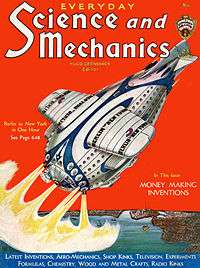
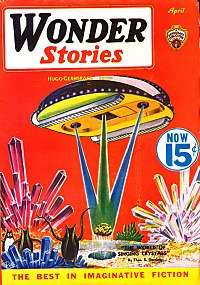
- Air Wonder Stories – July 1929 to May 1930, merged with Science Wonder Stories to form Wonder Stories
- Amazing Detective Stories
- Amazing Stories
- Aviation Mechanics
- Electrical Experimenter – 1913 to 1920; became Science and Invention
- Everyday Mechanics – from 1929; changed to Everyday Science and Mechanics as of October 1931 issue
- Everyday Science and Mechanics – see Science and Mechanics
- The Experimenter – originally Practical Electrics, the first issue under this title was November 1924; merged into Science and Invention in 1926
- Facts of Life
- Flight
- Fotocraft
- French Humor – became Tidbits
- Gadgets
- High Seas Adventures
- Know Yourself
- Life Guide
- Light
- Luz
- Milady
- Modern Electrics – 1908 to 1914 (sold in 1913; new owners merged it with Electrician and Mechanic)
- Moneymaking
- Motor Camper & Tourist
- New Ideas for Everybody
- Pirate Stories
- Popular Medicine
- Popular Microscopy – at least thru May–June 1935 (vol 1 #6)
- Practical Electrics – Dec. 1921 to Oct. 1924, became The Experimenter
- Radio Amateur News – July 1919 to July 1920, dropped the word "amateur" and became just Radio News
- Radio and Television
- Radio-Craft — July 1929 to June 1948, became Radio-Electronics
- Radio-Electronics — July 1948 to January 2003
- Radio Electronics Weekly Business Letter
- Radio Listeners Guide and Call Book [title varies]
- Radio News — July 1919 (as Radio Amateur News) to July 1948
- Radio Program Weekly
- Radio Review
- Science and Invention – formerly Electrical Experimenter; published August 1920 to August 1931
- Science and Mechanics – originally Everyday Mechanics; changed to Everyday Science and Mechanics in 1931. "Everyday" dropped as March 1937 issue, and published as Science and Mechanics until 1976
- Science Fiction Plus – March to Dec. 1953
- Science Wonder Stories – June 1929 to May 1930, merged with Air Wonder Stories to form Wonder Stories
- Science Wonder Quarterly – Fall 1929 to Spring 1930, renamed Wonder Stories Quarterly and continuing to Winter 1933
- Scientific Detective Monthly
- Sexologia
- Sexology
- Short-Wave and Television
- Short-Wave Craft – merged into Radio-Craft
- Short-Wave Listener
- Superworld Comics
- Technocracy Review
- Television – 1928
- Television News – March 1931 to October 1932; merged into Radio Review, then into Radio News as of March 1933
- Tidbits, originally French Humor
- Woman's Digest
- Wonder Stories – June 1930 to April 1936
- Your Body
- Your Dreams
Patents
Gernsback held 80 patents by the time of his death in New York City on August 19, 1967.[34]
His first patent was a new method for manufacturing dry-cell batteries, a patent applied for on June 28, 1906 and granted February 5, 1907.[35]
Among his inventions are a combined electric hair brush and comb (US Patent 1,016,138), 1912; an ear cushion (US Patent 1,514,152), 1927; and a hydraulic fishery (US Patent 2,718,083), 1955.[36]
Other patents held by Gernsback are related to: Incandescent Lamp, Electrorheostat Regulator, Electro Adjustable Condenser, Detectorium, Relay, Potentiometer, Electrolytic Interrupter, Rotary Variable Condenser, Luminous Electric Mirror, Transmitter, Postal Card, Telephone Headband, Electromagnetic Sounding Device, Submersible Amusement Device, Apparatus for Landing Flying Machines, Tuned Telephone Receiver, Electric Valve, Detector, Acoustic Apparatus, Electrically Operated Fountain, Cord Terminal, Coil Mounting, Radio Horn, Variable Condenser, Switch, Telephone Receiver, Crystal Detector, Process for Mounting Inductances, Depilator, Switch, Code Learner's Instrument.[35]
Bibliography
Novels:
- Ralph 124C 41+ (1911)
- Baron Münchausen's Scientific Adventures (1928)
- Ultimate World (1971)
Short stories:
- "The Electric Duel" (1927)
- "The Killing Flash" (1929)
- "The Cosmatomic Flyer" Science-Fiction Plus (March 1953)
Notes
- The first eight monthly issues included installments of at least one Verne story and for more than two years every one featured a Wells story.[7]
References
- Siegel, Mark Richard (1988). Hugo Gernsback, Father of Modern Science Fiction: With Essays on Frank Herbert and Bram Stoker. Borgo Pr. ISBN 0-89370-174-2.
- "Hugo Awards". The Locus Index to SF Awards: About the Awards. Locus Publications. Archived from the original on 2010-01-03. Retrieved 2013-03-24.
- http://www.fofweb.com/History/MainPrintPage.asp?iPin=AIE0103&DataType=AmericanHistory&WinType=Free
- "Look! Up in the sky! It's a Jew! - New Jersey Jewish News". njjewishnews.com.
- O'Neil, Paul (July 26, 1963). "Barnum of the Space Age". Life. New York: Time. 55 (4): 62–68. ISSN 0024-3019.
- Massie, K., & Perry, S. D. (2002). Hugo Gernsback and Radio Magazines: An Influential Intersection in Broadcast History." Journal of Radio Studies, 9, pp. 267–268.
- Hugo Gernsback at the Internet Speculative Fiction Database (ISFDB). Retrieved 2013-04-20. Select a title to see its linked publication history and general information. Select a particular edition (title) for more data at that level, such as a front cover image or linked contents.
- "Hugo Gernsback Is Dead at 83. Author, Publisher and Inventor. 'Father of Modern Science Fiction'. Predicted Radar. Beamed TV in '28. 'One to Forsee [sic] for All'". The New York Times. August 20, 1967. Retrieved 2010-12-06.
Hugo Gernsback, an inventor, author, editor and publisher who has been called the father of modern science fiction, died yesterday at Roosevelt Hospital. He was 83 years old and lived at 263 West End Avenue.
- Gunn, James (2002). The Road to Science Fiction: From Wells to Heinlein. Scarecrow Press. ISBN 978-0810844391.
- Pohl, Frederik (December 1967). "On Hugos". Galaxy Science Fiction. pp. 6, 8.
- Bleiler, Everett F. (1990). Science-Fiction, The Early Years. Kent State University Press. p. 282.
- De Camp, L. Sprague (1975). Lovecraft: a Biography. Doubleday. ISBN 0385005784.
- Banks, Michael A. (1 October 2004). "Hugo Gernsback: The man who invented the future. Part 3. Merging science fiction into science fact". The Citizen Scientist. Society for Amateur Scientists. Archived from the original on 26 February 2011. Retrieved 2007-02-13.
- Ashley, Mike; Ashley, Michael; Lowndes, Robert A. W. (2004). The Gernsback Days. Wildside Press LLC. p. 241.
- De Camp, L. Sprague (1975). Lovecraft: a Biography. Doubleday. p. 298. ISBN 0385005784.
- Resnick, Mike; Malzberg, Barry (Dec 2009 – Jan 2010). "Resnick and Malzberg Dialogues XXXXVI: The Prozines (Part 1)". The SFWA Bulletin. 43 (5): 27–28.
- "Larry McCaffery – An Interview with Jack Williamson". www.depauw.edu.
- Pohl, Frederik (October 1965). "The Day After Tomorrow". Editorial. Galaxy Science Fiction. pp. 4–7.
- Westfahl, Gary (1999). The Mechanics of Wonder: The Creation of the Idea of Science Fiction. Liverpool University Press. p. 135.
- Shippey, T. A.; Sobczak, A. J. (1996). Magill's Guide to Science Fiction and Fantasy Literature Volume 3: Lest Darkness Fall. Salem Press. p. 767.
- Aldiss, Brian W., Billion Year Spree: The True History of Science Fiction (1973), Doubleday and Co., pp. 209-10
- Westfahl, Gary (1999). The Mechanics of Wonder: The Creation of the Idea of Science Fiction. Liverpool University Press. p. 92.
- Westfahl, Gary (1999). The Mechanics of Wonder: The Creation of the Idea of Science Fiction. Liverpool University Press. p. 93.
- del Rey, Lester (June 1972). "Reading Room". If. p. 111.
- "Books", F&SF, January 1973, p. 47
- "Remembering the father of science fiction" Luxembourg Times 16 August 2016
- "Minutes of the Business Meeting 1991". World Science Fiction Society. Archived from the original on 2011-05-07. Retrieved 2013-03-24. Preliminary Session #1, Item E.2; Main Session #1, Item F.3 (August 30/31, 1991).
- "The Hugo Awards by Year". World Science Fiction Convention. 1960. Archived from the original on 2013-01-20. Retrieved 2013-02-03.
- "Gernsback, Hugo" Archived 2015-03-27 at the Wayback Machine. The Locus Index to SF Awards: Index of Literary Nominees. Locus Publications. Retrieved 2013-03-24.
- "Science Fiction and Fantasy Hall of Fame" Archived 2013-05-21 at the Wayback Machine. Mid American Science Fiction and Fantasy Conventions, Inc. Retrieved 2013-03-23. This was the official website of the hall of fame to 2004.
- Aldiss, Brian W., Billion Year Spree: The True History of Science Fiction (1973), Doubleday and Co., p. 209
- Massie, K.; Perry, S. D. (2002). "Hugo Gernsback and radio magazines: An influential intersection in broadcast history". Journal of Radio Studies (9): 264–281.
- Stashower, D. (August 1990). "A dreamer who made us fall in love with the future". Smithsonian. Vol. 21 no. 5. pp. 44–55.
- Frederic Krome, "Introduction to 'Hugo Gernsback and World War I", in Krome, ed., Fighting the Future War: An Anthology of Science Fiction War Stories, 1914-1945 (London: Routledge, 2012), 21. ISBN 1136683143, 9781136683145; many repeat the "80 patents" detail, sometimes as "over 80" or "some 80," starting in Sexology 34/11 (NY, 1967), 293.
- "Hugo Gernsback's Patents". Amazing Stories. Retrieved 3 November 2019.
- "Hugo Gernsback's Unconventional Inventions". LEMELSON CENTER for the Study of Invention and Innovation. Retrieved 3 November 2019.
Further reading
- Ackerman, Forrest J (1997). Forrest J Ackerman's World of Science Fiction. Los Angeles: RR Donnelley & Sons. pp. 28, 31, 78–79, 107–111, 118–122. ISBN 1-57544-069-5.
- Ashley, Mike (2004). The Gernsback Days. Holicong, PA: Wildside Press. ISBN 0-8095-1055-3.
- Massie, K.; Perry, S. (2002). "Hugo Gernsback and radio magazines: An influential intersection in broadcast history" (PDF). Journal of Radio Studies. 9 (2): 264–281. Archived from the original (PDF) on 2007-07-04. Retrieved 2007-03-02.
- Shunaman, Fred (October 1979). "50 Years of Electronics". Radio Electronics. Gernsback Publications. 50 (10): 42–69.
- Stashower, Daniel (August 1990). "A Dreamer Who Made Us Fall in Love with the Future". Smithsonian. 21 (5): 44–55.
- Westfahl, Gary (2007). Hugo Gernsback & the Century of Science Fiction. Jefferson, NC: McFarland. ISBN 978-0-7864-3079-6.
- Wythoff, Grant (2016). The Perversity of Things: Hugo Gernsback on Media, Tinkering, and Scientifiction. Minneapolis, MN: University of Minnesota Press. ISBN 978-1-5179-0085-4.
External links
| Wikimedia Commons has media related to Hugo Gernsback. |
- Works by Hugo Gernsback at Project Gutenberg
- Gernsback image at Life.com
- Radio Before Radio at the web site of the American Radio Relay League
- Gernsback interviewed on Horizon, 1965
- Hugo Gernsback Library & Publications, AmericanRadioHistory.Com
- Biography and criticism
- "Hugo Gernsback biography". Science Fiction and Fantasy Hall of Fame.
- "Boys of Wireless" at American Experience (PBS)—Contains information about Gernsback's role in early amateur radio
- Hugo Gernsback, Publisher – discussion of Gernsback as a magazine publisher, with links to cover images of most of his technical and other non-fiction magazines
- Bibliography and works
- Hugo Gernsback at the Internet Speculative Fiction Database
- Hugo Gernsback Papers – description of his papers in the Special Collections Research Center of the Syracuse University Library